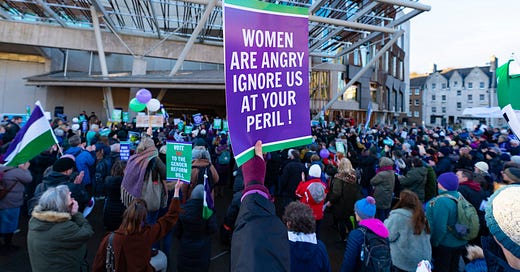The Hearing took place in Court One at the Supreme Court on Parliament Square. Unfortunately I couldn’t get a seat so I ended up in the over flow Court Two but I did get a desk! I hadn’t brought my laptop because I thought that there was no way I would get a desk, so I will bring my laptop tomorrow!! So I had to resort to scribbling notes.
The judges are: Lady Rose, Lady Simler and Lords Hodge, Reed and Lloyd-Jones.
Today, I thought Aidan O’Neill KC for For Women Scotland and Ben Cooper KC for Sex Matters did great jobs. I especially liked Mr O’Neill’s initial points about women under the common law ( see below for what ‘common law’ is) and the patriarchy. He apologised if he was mansplaining feminism 😀
FWS, as appellants, got 3 hours and Sex Matters, as interveners, got one hour.
Tomorrow we have Ruth Crawford KC for The Scottish Ministers and Jason Coppell KC for the Equality and Human Rights Commission (EHRC). EHRC are taking a very weird position on this - see further below.
Strangely, after Day One, it is Lady Rose and Lady Simler I am most worried about in terms of their interventions and questions!
If you want much fuller details of submissions please go to wonderful Tribunal Tweets https://x.com/tribunaltweets?mc_cid=1c7339e853&mc_eid=b7da81a2c7
I am providing excerpts of some of the main points.I did not have a trial bundle so could not really note down full details of the legal cases being relied on but my last update had links to all submissions.
All comments and any queries gratefully received.
I am using here the Thomson Reuters definition of ‘common law’:
Common law legal systems can trace their roots back many centuries. Indeed, the common law system as we know it started in England during the Middle Ages. Even today, several countries around the world — including the U.S., Canada, India, and Australia — continue to rely heavily on common law when resolving their legal disputes.
….
The simplest definition for common law is that it’s a “body of law” based on court decisions rather than codes or statutes. But in reality, common law is often more complicated than that.
At the center of common law is a legal principle known as stare decisis, which is a Latin phrase that roughly means “to stand by things decided.” In practice, stare decisis is just a fancy way of saying that courts and judges need to follow earlier decisions and rulings — otherwise known as caselaw — when dealing with similar cases later.
For example, if a court makes a particular decision based on a specific set of facts, then the court is required to follow that decision if they ever must make a ruling on the same or closely related issue. Likewise, decisions made by higher courts — like a jurisdiction’s supreme court — are typically binding on lower courts in the same jurisdiction.
The case was started by Aidan O’Neill KC on behalf of For Women Scotland.
He expressed surprise that Amnesty International (A) were supporting the Scottish Ministers (SM) since they dealt with incarcerated women around the world.
He said he would be arguing that including those with Gender Recognition Certificates (GRCs) under the meaning of ‘sex’ was unworkable. The EHRC were wrong in saying that despite the problems caused this is what Parliament intended.
Section 9(1) of the GRA 2004 creates a legal fiction. Section 9(3) says this is subject ‘to any other enactment.
FWS are arguing it is an ‘immutable biological state’ and that this is not ‘transphobic.’
Context is everything. Women do not start off with a level playing field against men. The common law regarded being a woman as a type of disability. For example it used to be the case that a woman could not own property without the consent of a man .
Discrimination is now outlawed and this happened because of what being a woman meant in common law. He referred to 19th century cases where university graduates had a vote and eventually women were allowed to do degrees but a later legal case decided that this did not mean that women graduates could vote. At this stage women were not regarded as ‘persons’. This is antediluvian but some of these types of decisions continued into the 20th century so almost within living memory.
There are mainly men presenting this case and 10 out of the 12 Supreme Court judges are men. This shows, argued Mr O’Neill, how insidious the patriarchy is.
He referred to examples of the patriarchy including a rape survivor being told to ‘re-frame her trauma’ ( the Edinburgh Rape Crisis Centre case) and a lesbian group being told they need to include men who have a GRC.
It used to be biological determinism and is now biological denialism.
When a natal man says a GRC allows him into women’s spaces that is the patriarchy in action.
The EHRC accept that, if you include men with GRCs in the definition of ‘woman’ for the purposes of the Equality Act (EqA) that leads to ‘absurd consequences’. A natal male who identifies as a woman and has a GRC and wants to date women is seen as same sex attracted but a natal male who identifies as a woman and wants to date women but doesn’t have a GRC is not seen as same sex attracted. [ Dusty - bear with me, I’m just presenting the arguments!].
This impairs the proper functioning of the EqA and is a wholly unsatisfactory state of affairs.
Michael Foran got quoted! He says that the SM version of the definition renders the single sex provisions of the EqA virtually meaningless.
The EHRC also say that you should not ask a natal male who is claiming access to women’s single sex services whether he has a GRC! Under the Gender Recognition Act (GRA) 2004 s22(3), if someone has acquired a GRC, those in public office, employers etc cannot disclose that fact without permission from the person with the GRC. So how can a ward sister, for example, make an assessment of whether this is really a single sex ward or not?
Under the SM definition:
‘Men’ would include natal males, natal females with a GRC and natal males who identify as women but do not have a GRC;
‘Women’ would include natal females, natal males with a GRC and natal females who identify as men but do not have a GRC.
The SM definition has a ridiculous result with regard to: cervical cancer screening; domestic violence support groups; single sex hospital wards; separate changing rooms; massage services etc
According to the EqA s7 definition of the protected characteristic of ‘gender reassignment’ this refers to changing ‘physiological attributes’ , so this must be in a biological sense.
On the other hand, if the SM definition is correct, natal females with a GRC would lose the right to enter women’s single sex spaces! There are many protections related to pregnancy and maternity pay within the EqA. A pregnant female with a GRC could not claim these rights! Also they do not have a comparator in a sex discrimination claim because, of course, natal men cannot become pregnant ( this got a big laugh from the public gallery).
With regard to the EqA provisions dealing with pregnancy, EHRC concede that you would need a different definition i.e. a biological one. Obviously, it is unsatisfactory to have two different definitions for a word.
When GRA s9(1) talks of ‘for all purposes’ it means for the purposes of the Act itself. Section 9(3) refers to it being subject to any other provision in another enactment and thus avoids the ridiculous outcomes mentioned above.
Instead of all the ridiculous complications mentioned above which would result from the SM position, it is simple and straightforward if men means men and women means women!
Next was Ben Cooper KC for Sex Matters.
We need an ordinary statutory construction of the meaning of the words.
GRA s9(1) is not a fundamental constitutional right such as section 3 of the Human Rights Act 1998 ( declaration of incompatibility with one of the listed human rights).
The GRA was brought in to force to comply with the European Court of Human Rights judgment in Goodwin V UK. Parliament has decided to regulate the relationship with people identifying as ‘trans’ by means of ‘gender reassignment’ which involves different criteria than the criteria that applies to GRCs.
In terms of the EqA it is the protected characteristics that are known about that are important not a confidential GRC. Gender reassignment does not involve possession of a GRC. How are employers and others meant to know if someone has a GRC or not?
Stop Press
I had a slightly bizarre lunch break. I didn’t want to lose my desk so stayed in the court room and surreptitiously ate my sandwich (you’re not meant to eat in court rooms!). A party of school children came in and, after explaining the basics of the court to them, their teacher gave them, as an example of a Supreme Court case - the ‘gay cake’ case!! He didn’t seem to know that that case then went to the European Court of Human Rights - I didn’t embarrass him 😀 The latter dismissed the case thus, effectively, upholding the Supreme Court ruling that the cake shop were entitled to refuse to make the cake because the message on it was in conflict with their religious views:
https://www.bbc.co.uk/news/uk-northern-ireland-59882444
#BeMorePorcupine
#LetWomenSpeak
#Grassroots Army
#GenderIdeologyIsEvil
#VoteAontú
#Woman:AdultHumanFemale
#ForWomenScotland








Thanks Dusty. I agree with Petal, I’m sick of listening to insane people spouting word salad so thanks for doing this so we don’t have to. 😂 you’re a star.
thanks Dusty, i was considering rejoining the internet to follow this but now i will be delighted as having a man on the inside to report accurately what is going on! is this the beginning of the end for gender ideology?! its so key that children know the legal implications of pretending they aren’t what they are. If boys and men learn categorically that they aren’t allowed into women’s spaces i reckon they will just move on to something else. Then we’ll be left with the genuinely dysphoric people who we care love and care for to the best of our abilities.
Thanks Dusty!